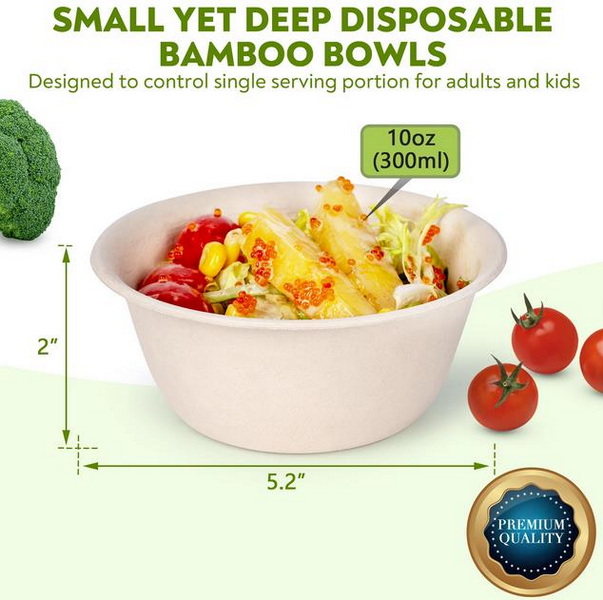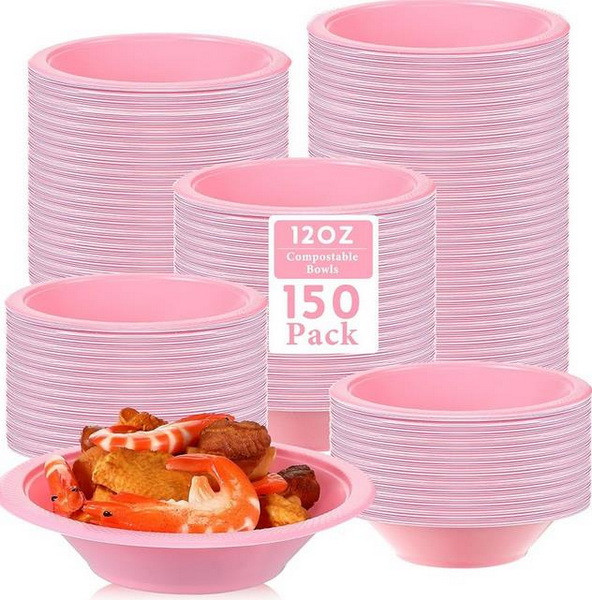
Content Menu
● What Are Disposable Small Bowls?
>> Key Features of Disposable Small Bowls
● Types of Disposable Small Bowls
>> 1. Plastic Disposable Bowls
>> 2. Paper Disposable Bowls
>> 3. Eco-Friendly Disposable Bowls
● Cost Comparison
● Quality Considerations
>> Durability
>> Design
>> Eco-Friendliness
● When to Use Disposable Small Bowls
● Factors Influencing Choice of Disposable Small Bowls
>> 1. Event Type
>> 2. Food Type
>> 3. Environmental Impact
>> 4. Budget Constraints
● Innovations in Disposable Small Bowls
>> 1. Plant-Based Plastics
>> 2. Edible Bowls
>> 3. Foldable Designs
● Tips for Choosing the Right Disposable Small Bowl
● The Impact of Disposable Small Bowls on the Environment
>> Plastic Pollution
>> Deforestation Concerns
>> Composting Solutions
● Future Trends in Disposable Small Bowls
● Conclusion
● FAQs
>> 1. What is the best material for disposable small bowls?
>> 2. Can disposable small bowls be reused?
>> 3. Are there microwave-safe disposable small bowls?
>> 4. How do I dispose of disposable small bowls responsibly?
>> 5. Are disposable small bowls suitable for hot foods?
Disposable small bowls have become an essential item for various occasions, ranging from casual gatherings to formal events. They offer convenience, versatility, and often an elegant touch to table settings. This article explores the quality, cost, and practical considerations of disposable small bowls, helping you make informed decisions for your next event.

What Are Disposable Small Bowls?
Disposable small bowls are single-use containers designed for serving food. They come in a variety of materials, including plastic, paper, and eco-friendly options like sugarcane or bamboo. These bowls are ideal for serving appetizers, desserts, or smaller portions of meals.
Key Features of Disposable Small Bowls
1. Convenience: Easy to use and dispose of after meals.
2. Variety: Available in numerous designs, sizes, and materials.
3. Cost-Effective: Affordable options for bulk purchases.
4. Eco-Friendly Choices: Compostable and biodegradable options are available.
Types of Disposable Small Bowls
1. Plastic Disposable Bowls
Plastic bowls are durable and often mimic the appearance of glass or ceramic. They are ideal for events requiring a polished look without the hassle of cleanup.
Examples:
- Visions Clear Square Plastic Mini Bowl (2.5 oz) at $0.13 per unit.
- WNA Comet Black Plastic Bowl (10 oz) at $0.55 per unit.
Advantages:
- Sturdy and reusable if desired.
- Available in various styles like gold-rimmed or clear designs.
Disadvantages:
- Not always eco-friendly unless made from recyclable materials.
2. Paper Disposable Bowls
Paper bowls are lightweight and often feature colorful prints or patterns.
Examples:
- Dixie Ultra Soak-Proof Paper Bowls (20 oz).
- Glad Palm Leaf Print Paper Bowls (16 oz).
Advantages:
- Microwave-safe and soak-proof.
- Suitable for both hot and cold foods.
Disadvantages:
- Less durable compared to plastic options.
3. Eco-Friendly Disposable Bowls
Eco-friendly bowls are made from materials like sugarcane bagasse or bamboo.
Examples:
- Stack Man Sugarcane Fiber Bowls (12 oz).
- EcoSoul Compostable Sugarcane Bowls (16 oz).
Advantages:
- Biodegradable and compostable.
- Sustainable alternative to traditional materials.
Disadvantages:
- Higher cost compared to standard plastic or paper bowls.

Cost Comparison
The cost of disposable small bowls varies based on material, design, and purchase quantity:
| Material | Price Range (Per Unit) | Example Product |
| Plastic | $0.12–$0.55 | Visions Clear Mini Bowl ($0.13/unit) |
| Paper | $0.20–$0.50 | Dixie Ultra Bowls ($0.31/unit) |
| Eco-Friendly | $0.30–$0.60 | Stack Man Sugarcane Bowls ($0.43/unit) |
Bulk purchases can significantly reduce costs, especially for large events.
Quality Considerations
When selecting disposable small bowls, quality is crucial to ensure functionality and aesthetics:
Durability
Plastic bowls tend to be more durable than paper options, making them suitable for heavier foods like soups or stews. The thickness of the material plays a significant role in determining how well the bowl will hold up under different types of food.
Design
Elegant designs such as gold-rimmed edges or clear finishes enhance the presentation of meals, particularly in formal settings. Some disposable small bowls come with intricate patterns or textures that can elevate the dining experience.
Eco-Friendliness
For environmentally conscious consumers, compostable options made from sugarcane or bamboo are preferable. These materials break down naturally, reducing environmental impact.
When to Use Disposable Small Bowls
Disposable small bowls are versatile and suitable for various occasions:
1. Parties & Events: Simplify cleanup after gatherings.
2. Catering Services: Provide a professional yet disposable option.
3. Outdoor Picnics: Lightweight and easy to transport.
4. Everyday Use: Convenient for quick meals or snacks at home.
Factors Influencing Choice of Disposable Small Bowls
1. Event Type
The nature of your event can dictate the type of disposable small bowl you choose. For formal events, plastic bowls with a premium look might be more appropriate, while casual gatherings might be well-served by paper or eco-friendly options.
2. Food Type
Consider the type of food you'll be serving. Hot soups or sauces require sturdier bowls, while cold salads or desserts can be served in lighter options.
3. Environmental Impact
If sustainability is a priority, opt for biodegradable or compostable disposable small bowls. These options help reduce your event's carbon footprint.
4. Budget Constraints
While eco-friendly options might be desirable, they often come at a higher cost. Balance your budget with your preferences to find the best solution.
Innovations in Disposable Small Bowls
The market for disposable small bowls is constantly evolving, with new materials and designs being introduced:
1. Plant-Based Plastics
Some manufacturers are now producing disposable small bowls from plant-based plastics, which offer the durability of traditional plastic with improved biodegradability.
2. Edible Bowls
Innovative companies have developed edible disposable small bowls made from ingredients like wheat bran. These bowls can be eaten along with the food, eliminating waste entirely.
3. Foldable Designs
Space-saving foldable disposable small bowls are gaining popularity, especially for outdoor events and picnics where storage space is limited.
Tips for Choosing the Right Disposable Small Bowl
1. Consider the Occasion: Match the style of the bowl to the formality of your event.
2. Estimate Quantity Needed: Buy in bulk to save money, but avoid overordering.
3. Check for Certifications: Look for FDA-approved or compostable certifications if applicable.
4. Test Before Bulk Purchase: Order samples to test quality and suitability for your needs.
5. Read Reviews: Check customer reviews for real-world performance insights.
The Impact of Disposable Small Bowls on the Environment
While disposable small bowls offer convenience, it's important to consider their environmental impact:
Plastic Pollution
Non-biodegradable plastic bowls contribute to plastic pollution if not properly recycled. Opting for recyclable plastic or biodegradable alternatives can help mitigate this issue.
Deforestation Concerns
Paper bowls, while biodegradable, may contribute to deforestation if not sourced responsibly. Look for bowls made from recycled paper or sustainable forestry practices.
Composting Solutions
Eco-friendly disposable small bowls made from materials like sugarcane or bamboo can be composted, returning nutrients to the soil and reducing waste in landfills.
Future Trends in Disposable Small Bowls
The disposable small bowl industry is likely to see several trends in the coming years:
1. Increased Use of Recycled Materials: More manufacturers are expected to use recycled plastics and papers in their products.
2. Advanced Biodegradable Materials: Research into new biodegradable materials could lead to more eco-friendly options that decompose faster.
3. Smart Packaging: QR codes on disposable small bowls could provide information about proper disposal methods or the bowl's environmental impact.
4. Customization Options: Increased demand for personalized disposable small bowls for events and branding purposes.
5. Regulatory Changes: Stricter regulations on single-use plastics may drive innovation in alternative materials.
Conclusion
Disposable small bowls offer a balance between convenience, cost-effectiveness, and style. Whether you prioritize durability with plastic options or sustainability with eco-friendly materials, there is a disposable bowl to fit every need and budget. As the industry continues to innovate, consumers can expect more environmentally friendly and versatile options in the future. By considering factors such as event type, food requirements, and environmental impact, you can make an informed choice that best suits your needs while minimizing ecological consequences.

FAQs
1. What is the best material for disposable small bowls?
The best material depends on your specific needs. Plastic offers durability, paper is lightweight, and eco-friendly options like sugarcane provide sustainability. Consider your event type, food being served, and environmental concerns when choosing.
2. Can disposable small bowls be reused?
Many plastic bowls can be reused if washed gently; however, most are designed for single use. Paper and biodegradable bowls are generally not suitable for reuse.
3. Are there microwave-safe disposable small bowls?
Yes, many paper and eco-friendly bowls are microwave-safe, such as Dixie Ultra Soak-Proof Bowls. Always check the packaging for microwave safety instructions.
4. How do I dispose of disposable small bowls responsibly?
Recycle plastic bowls marked as recyclable. Compost biodegradable options like sugarcane-based products. For paper bowls, check local recycling guidelines as some may be recyclable if not heavily soiled.
5. Are disposable small bowls suitable for hot foods?
Yes, most high-quality disposable bowls can handle hot foods without leaking or warping. However, always check the product specifications to ensure they are suitable for your intended use.

















